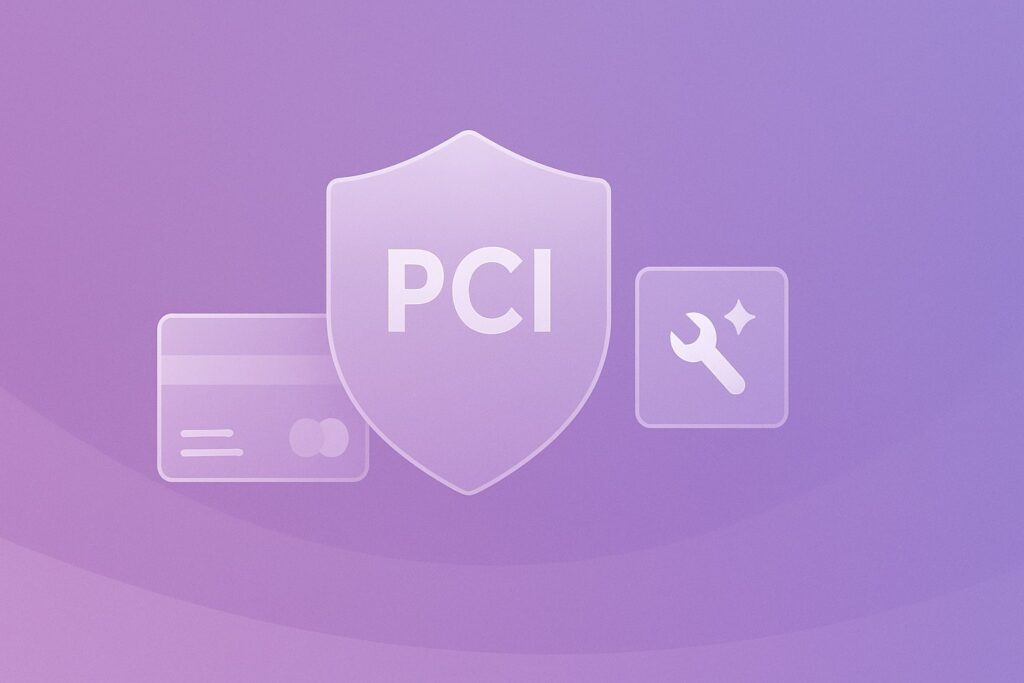A round-up of 8 PCI scan tools to achieve and maintain PCI compliance.
Meeting PCI DSS compliance standards isn’t simple. Compliance isn’t a one-time achievement, especially within complex cloud infrastructures. You can’t just set it and forget it. Do you accept, process, or store credit card data?
Then you must prove your systems stay secure. You need to do this continuously. The rules change based on your transaction volume.
Many PCI compliance test tools exist to help merchants prepare for audits. They help maintain payment security protocols.
Below are eight of the most useful tools. We also share tips to build security into your payment systems from day one.
Need to brush up on the basics of PCI Compliance? Check out The Complete Guide to PCI Compliance.
Key Takeaways
- Complying with the Payment Card Industry (PCI) standards (e.g., PCI DSS) can have many twists and turns. For one, there is no such thing as a one-and-done compliance process.
- If you accept, process, or store credit card data, you must continually prove that your systems are secure.
- The rules for compliance also differ depending on the volume of transactions you process, so the steps you may need to take may change as your business grows.
PCI Compliance Built-into Your Payments Systems
The easiest way to stay PCI compliant is simple. Start with built-in security protocols. Make security part of your workflow from day one. Adjustments are still simple at this stage. This approach works much better than the alternative.
What’s the alternative? You build a complete product first. Then you check it for security standards. Then you go back and undo your work. This frustrates your team. It delays your market launch. It makes investors impatient.
Out-of-the-box compliance solutions are a way to get a jump on the complexities of PCI compliance with built-in standards. DuploCloud’s DevSecOps automation platform lets your team work with an environment designed for PCI compliance, which means you’ll be able to meet 90% of the required standards before the development cycle is complete.
If you want to learn more about PCI compliance with DuploCloud, give this whitepaper a read.

8 Best PCI Scan Compliance Test Tools
Based on our experience and expertise with PCI compliance, we have compiled a list of the 8 best PCI scan tools that your organization’s DevOps and cybersecurity teams could try.
1. OSSEC
An open source free intrusion detection system (IDS), OSSEC is widely used by IT teams across industries to run PCI compliance tests. The scanning solution comes with a centralized management server to help you oversee policies across multiple operating systems. Once downloaded, OSSEC actively monitors and analyzes your log activity to detect rootkits and malicious applications.
If an intrusion is detected, OSSEC will respond to the threat in real-time through integration with your security policies. If your security is especially robust, this could involve fighting back with your AI agents.
Companies that need to comply with PCI standards can use OSSEC to cover requirements 10 and 11 (file integrity monitoring, log inspection and monitoring, and policy enforcement/checking).
2. Snort
Snort is another open-source IDS that can be used as a PCI compliance scan tool for Windows and Linux systems. It works similarly to OSSEC in that it can analyze log data and send alerts if suspicious activity is detected.
It can also function as a packet sniffing tool, examining streams of data traffic as they flow between devices on your network and between your devices and the internet.
There is a free version of Snort, though there are paid versions with additional features, like priority response for false positives and rules. Users can find complete documentation and rulesets on the Snort website.
One of the biggest benefits of Snort is its thriving user community, with mail lists, opportunities to contribute code, and submission of bug reports all contributing to the collaborative environment.
3. 1Stop PCI Scan from Backbone Security
With 20 years of experience under its belt, Backbone Security’s 1Stop PCI Scan solution is widely used for PCI compliance tests and certified as an Approved Scanning Vendor by PCI. To remain compliant, all organizations need to perform a quarterly system scan, and 1Stop provides just that, plus remediation consultations and a host of helpful add-ons, like self-scheduled scanning.
1Stop PCI Scan also conducts annual system penetration testing. They will conduct a simulation of an attack on your system and see how it holds up, which is a sub-requirement in criterion 11 of PCI DSS 3.2.
After conducting the test, 1Stop will provide you with a detailed report and remediation plan if system vulnerabilities are detected.
4. LogicManager
LogicManager offers a suite of PCI compliance scan tools, including One-Click Compliance, which uses an AI-powered search to sift through your entire library of existing IT protocols. That means your team won’t need to scroll through hundreds of documentation pages when you’re preparing for an audit.
You also get access to a central hub where you can view common controls, delegate remediation tasks, and track your PCI compliance. Because staying compliant is an ongoing process, LogicManager also offers reporting tools that track control deficiencies, show a full history of compliance with the 12 requirements, and provide readiness summaries. In other words, LogicManager is a fairly comprehensive all-in-one tool that both prepares you for a PCI compliance audit and helps you maintain required standards.
5. SolarWinds Security Event Manager (SEM)
SolarWinds SEM uses log data and built-in PCI DSS rules to detect vulnerabilities across your entire IT infrastructure. Among its many applications, it can be used as a PCI compliance scanner tool.
Users can schedule automatic reports (with built-in compliance controls) weeks or months in advance, making planning for audits easier. SolarWinds SEM also includes maintenance features, like file integrity monitoring (FIM) templates to help your team test security measures in key files.
This tool goes beyond assisting your team with remediation efforts by providing you with documentation you can use to complete a self-assessment questionnaire or share with a PCI QSA during an audit. A 30-day free trial is available.
6. Nagios Network Analyzer
Nagios Network Analyzer helps conduct PCI compliance scans through extensive network monitoring. It comes with a comprehensive dashboard where your team can quickly get a bird’s eye view of your network security.
Nagios also provides you with visualization tools, which make it easy to generate reports for an upcoming audit or to bolster your current documentation.
Nagios will automatically alert your team if abnormal activity takes place or if bandwidth usage exceeds specified thresholds. Nagios offers a free 30-day trial, after which you’ll need to purchase a license key.
7. Secureframe
Secureframe specializes in streamlining and automating compliance and also offers PCI compliance training. It supports both Level 1 companies that are going through an audit as well as Level 2 and 3 companies that need to complete a self-assessment questionnaire.
If you’re not sure which level you are, Secureframe’s team can help you decide and guide you through over 300 PCI DSS compliance sub-requirements.
Once you achieve compliance, Secureframe can help you maintain it with a cloud services monitoring feature, which integrates with the rest of your tech stack. It’s a one-stop solution for PCI compliance, great for teams who don’t have time or resources to cobble together various tools to achieve compliance.
8. Strike Graph
StrikeGraph can help your business achieve compliance with several standards, including PCI DSS, SOC 2, and GDPR. The process for PCI DSS compliance begins with a risk assessment conducted through StrikeGraph’s platform, after which you’ll receive a gap analysis and the corresponding tools needed for remediation.
All of this can be viewed from a single compliance dashboard. StrikeGraph can also connect your business with an approved PCI assessor and scale your solutions as your business grows.
Getting PCI Compliance Right From The Start
Scanning for PCI compliance regularly is valuable. Very valuable. But here’s the problem. What if you didn’t put the right PCI protocols in place at the start? Then you’ll find yourself working backwards often.
Building a product in the cloud without security protocols is like building a house without a plan. DuploCloud’s DevSecOps-as-a-Service platform is different. It’s like building a home with a solid blueprint in hand.
DuploCloud has built-in PCI DSS protocols. The DevSecOps platform gives you reporting services. It gives you cloud remediation services. These strengthen your existing security structure. They make sure preventable security incidents don’t slip through the cracks.
Schedule a demo with our team to learn more.
PCI Scan Compliance Frequently Asked Questions (FAQs)
What is PCI DSS compliance, and why do merchants need it?
PCI DSS stands for Payment Card Industry Data Security Standard. It’s a set of security requirements. All businesses must follow these requirements if they handle cardholder data.
Who needs to be PCI compliant? Any merchant that accepts debit, credit, prepaid cards, or any type of online payment. This also goes for any merchant that stores or transmits this information.
Compliance protects sensitive payment information. It prevents data breaches and fraud. Beyond avoiding fines, it helps businesses protect their reputation. It protects customer trust. Fines can reach $100,000 per month.
The requirements cover many areas. They cover network security. They cover access controls. They cover regular security testing.
How often do businesses need to conduct PCI compliance scans?
Businesses must conduct external vulnerability scans quarterly. That means every three months. These scans must be done by an Approved Scanning Vendor (ASV).
Organizations must also perform scans after any significant changes. These changes could be to their network or applications.
Level 1 merchants face the strictest requirements. These are merchants processing over 6 million transactions annually. They need annual on-site assessments. A Qualified Security Assessor (QSA) conducts these assessments.
Level 2 and 3 merchants have different requirements. They may complete annual self-assessment questionnaires instead. Internal scans should also be conducted quarterly. They should happen after significant changes too. This identifies vulnerabilities before they can be exploited.
What are the main PCI DSS requirements businesses must meet?
The PCI DSS framework includes 12 core requirements. These are organized into six main goals.
- The goals include building a secure network, and the following:
- Maintaining a secure network;
- Protecting cardholder data;
- Maintaining a vulnerability management program;
- Implementing strong access control measures;
- Regularly monitoring and testing networks;
- Maintaining an information security policy.
Each PCI requirement has multiple sub-requirements. These provide specific technical and operational standards.
For example, PCI requirement 11 mandates regular security testing. It mandates monitoring. Requirement 10 focuses on tracking all access. It tracks access to network resources and cardholder data.
Can small businesses use free tools to achieve PCI compliance?
Yes, small businesses can use free tools. Free open-source tools like OSSEC and Snort help. They help meet certain PCI DSS requirements. This is particularly true for monitoring and intrusion detection.
However, full compliance typically requires more than just using free tools.
Businesses still need quarterly scans, and these must be done by an Approved Scanning Vendor. They need to implement proper network segmentation. They need to maintain secure configurations. They need to document all security policies and procedures.
Free tools can reduce costs. But many small merchants find comprehensive platforms to save time. Managed services save time, too. They reduce the risk of missing critical requirements.
The investment in proper tools often costs less. It costs less than fines from a data breach. It costs less than remediation expenses from a breach.



